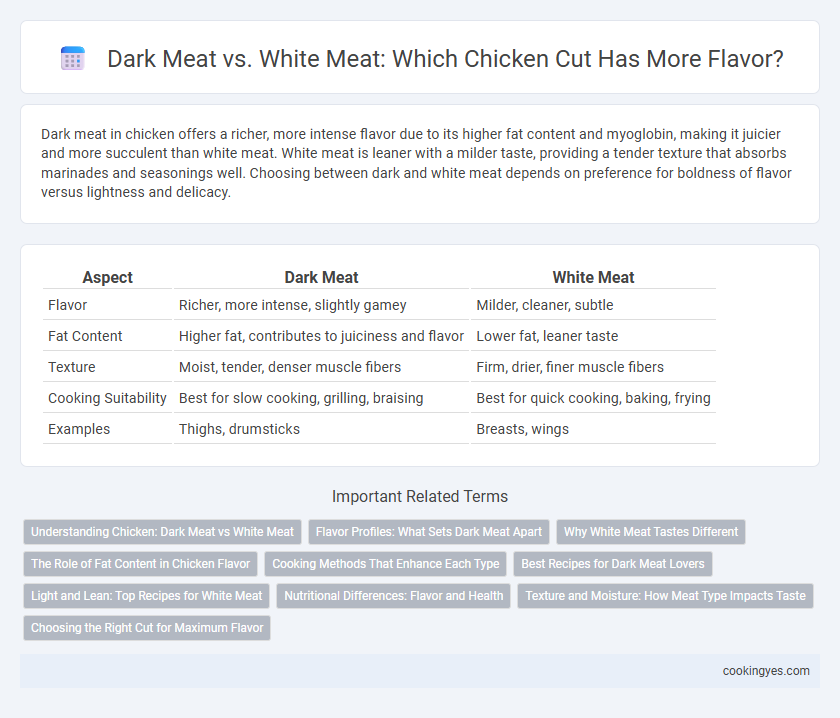Dark meat in chicken offers a richer, more intense flavor due to its higher fat content and myoglobin, making it juicier and more succulent than white meat. White meat is leaner with a milder taste, providing a tender texture that absorbs marinades and seasonings well. Choosing between dark and white meat depends on preference for boldness of flavor versus lightness and delicacy.
Table of Comparison
| Aspect | Dark Meat | White Meat |
|---|---|---|
| Flavor | Richer, more intense, slightly gamey | Milder, cleaner, subtle |
| Fat Content | Higher fat, contributes to juiciness and flavor | Lower fat, leaner taste |
| Texture | Moist, tender, denser muscle fibers | Firm, drier, finer muscle fibers |
| Cooking Suitability | Best for slow cooking, grilling, braising | Best for quick cooking, baking, frying |
| Examples | Thighs, drumsticks | Breasts, wings |
Understanding Chicken: Dark Meat vs White Meat
Dark meat chicken, found primarily in the legs and thighs, contains more myoglobin, giving it a richer flavor and moister texture compared to white meat from the breast and wings. This higher fat content and longer cooking time enhance the depth of savory notes, making dark meat ideal for slow-cooked and marinated dishes. White meat offers a milder taste and leaner profile, preferred for quick-cooking recipes and lower-fat dietary choices.
Flavor Profiles: What Sets Dark Meat Apart
Dark meat in chicken, found primarily in the thighs and drumsticks, is distinguished by its higher fat content and myoglobin levels, which contribute to a richer, more intense flavor profile compared to white meat. The increased fat enhances juiciness and depth, offering a savory and slightly gamey taste that is often preferred in slow-cooked or roasted dishes. Dark meat's unique combination of moisture, fat, and muscle fibers provides a robust, full-bodied flavor that stands out distinctly from the milder, leaner white meat.
Why White Meat Tastes Different
White meat chicken, primarily found in the breast, contains less myoglobin and fewer fat deposits than dark meat, resulting in a milder, more subtle flavor profile. The lower fat content in white meat produces a leaner texture and less intense taste, often described as slightly sweet or bland compared to the richer, more savory character of dark meat. White meat's faster muscle fibers contribute to its tender, less fibrous bite, influencing the overall taste experience distinct from the denser dark meat portions.
The Role of Fat Content in Chicken Flavor
Dark meat in chicken contains a higher fat content than white meat, which significantly enhances its rich and juicy flavor profile. This increased fat not only contributes to moisture retention during cooking but also intensifies the savory and umami notes, making dark meat more flavorful. In contrast, the leaner white meat has less fat, resulting in a milder taste and a drier texture when cooked.
Cooking Methods That Enhance Each Type
Dark meat chicken, rich in fat and connective tissue, benefits from slow cooking methods like braising or roasting to develop deep, savory flavors and tender texture. White meat, which is leaner and milder, is best suited to quick-cooking techniques such as grilling, sauteing, or poaching to preserve its moisture and delicate taste. Using marinades or brines can enhance juiciness and infuse complementary flavors regardless of the cooking method applied.
Best Recipes for Dark Meat Lovers
Dark chicken meat offers richer flavor and juicier texture compared to white meat, making it ideal for recipes that benefit from deep, savory profiles like coq au vin or slow-roasted thighs. Best recipes for dark meat lovers emphasize braising, grilling, or roasting with bold marinades including garlic, rosemary, and smoked paprika to enhance its natural umami and tenderness. Featuring cuts such as drumsticks and thighs, these dishes maximize the meat's fat content and connective tissue for succulent results perfect in comfort food classics.
Light and Lean: Top Recipes for White Meat
White meat from chicken, including the breast and wings, offers a light and lean flavor profile ideal for health-conscious recipes. Rich in protein and low in fat, white meat retains moisture well in dishes like grilled chicken breast, stir-fries, and baked chicken tenders. Popular recipes emphasize marinating, quick cooking, and seasoning techniques to enhance the mild taste and tender texture of white meat.
Nutritional Differences: Flavor and Health
Chicken dark meat contains higher fat content and richer nutrients such as iron and zinc compared to white meat, contributing to its more intense flavor and juiciness. White meat is leaner with lower calories and fat, making it a healthier choice for those seeking to reduce fat intake while still providing a good source of protein. The amino acid profile in dark meat promotes better flavor complexity while white meat's mild taste is preferred for versatile cooking and quicker preparation.
Texture and Moisture: How Meat Type Impacts Taste
Dark meat in chicken, primarily from the thighs and drumsticks, contains higher fat content and connective tissue, resulting in a juicier texture and richer flavor compared to white meat. White meat, found in the breast and wings, is leaner with less fat, producing a drier texture but a milder taste. The increased moisture in dark meat enhances tenderness and mouthfeel, making it favored for recipes requiring longer cooking times or bolder flavors.
Choosing the Right Cut for Maximum Flavor
Dark meat chicken, found in thighs and drumsticks, offers a richer, more intense flavor due to higher fat content compared to leaner white meat from breasts. The increased myoglobin in dark meat enhances juiciness and tenderness, making it ideal for slow-cooking or grilling to maximize flavor. Selecting dark meat cuts ensures a more flavorful and succulent chicken dish, especially when marinated or seasoned well.
Dark meat vs White meat for chicken flavor Infographic

 cookingyes.com
cookingyes.com